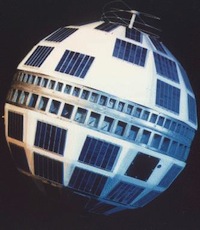
On this day in 1962 Telstar, the world’s first communications satellite, was launched into orbit.
Telstar 1 relayed its first, and non-public, television pictures—a flag outside Andover Earth Station—to Pleumeur-Bodou on July 11, 1962. Almost two weeks later, on July 23, at 3:00 p.m. EDT, it relayed the first publicly available live transatlantic television signal. The broadcast was made possible in Europe by Eurovision and in North America by NBC, CBS, ABC, and the CBC. The first public broadcast featured CBS’s Walter Cronkite and NBC’s Chet Huntley in New York, and the BBC’s Richard Dimbleby in Brussels. The first pictures were the Statue of Liberty in New York and the Eiffel Tower in Paris. The first broadcast was to have been remarks by President John F. Kennedy, but the signal was acquired before the president was ready, so the lead-in time was filled with a short segment of a televised major league baseball game between the Philadelphia Phillies and the Chicago Cubs at Wrigley Field. The batter, Tony Taylor, was seen hitting a ball pitched by Cal Koonce to the right fielder George Altman. From there, the video switched first to Washington, DC; then to Cape Canaveral, Florida; then to Quebec, Canada and finally to Stratford, Ontario. The Washington segment included a press conference with President Kennedy, talking about the price of the American dollar, which was causing concern in Europe.
During that evening, Telstar 1 also relayed the first telephone call to be transmitted through space, and it successfully transmitted faxes, data, and both live and taped television, including the first live transmission of television across an ocean from Andover, Maine to Goonhilly Downs, England and Pleumeur-Bodou, France. (An experimental passive satellite, Echo 1, had been used to reflect and redirect communications signals two years earlier, in 1960.) In August 1962, Telstar 1 became the first satellite used to synchronize time between two continents, bringing the United Kingdom and the United States to within 1 microsecond of each other (previous efforts were only accurate to 2,000 microseconds).
Telstar 1, which had ushered in a new age of the benevolent use of technology, became a victim of technology during the Cold War. The day before Telstar 1 was launched, the United States had tested a high-altitude nuclear bomb (called Starfish Prime) which energized the Earth’s Van Allen Belt where Telstar 1 went into orbit. This vast increase in radiation, combined with subsequent high-altitude blasts, including a Soviet test in October, overwhelmed Telstar’s fragile transistors; it went out of service in early December 1962, but was restarted by a workaround in early January 1963. The additional radiation associated with its return to full sunlight once again caused a transistor failure, this time irreparably, and Telstar 1 went out of service on February 21, 1963.
According to the US Space Objects Registry, Telstar 1 and 2 were still in orbit as of May 2012.